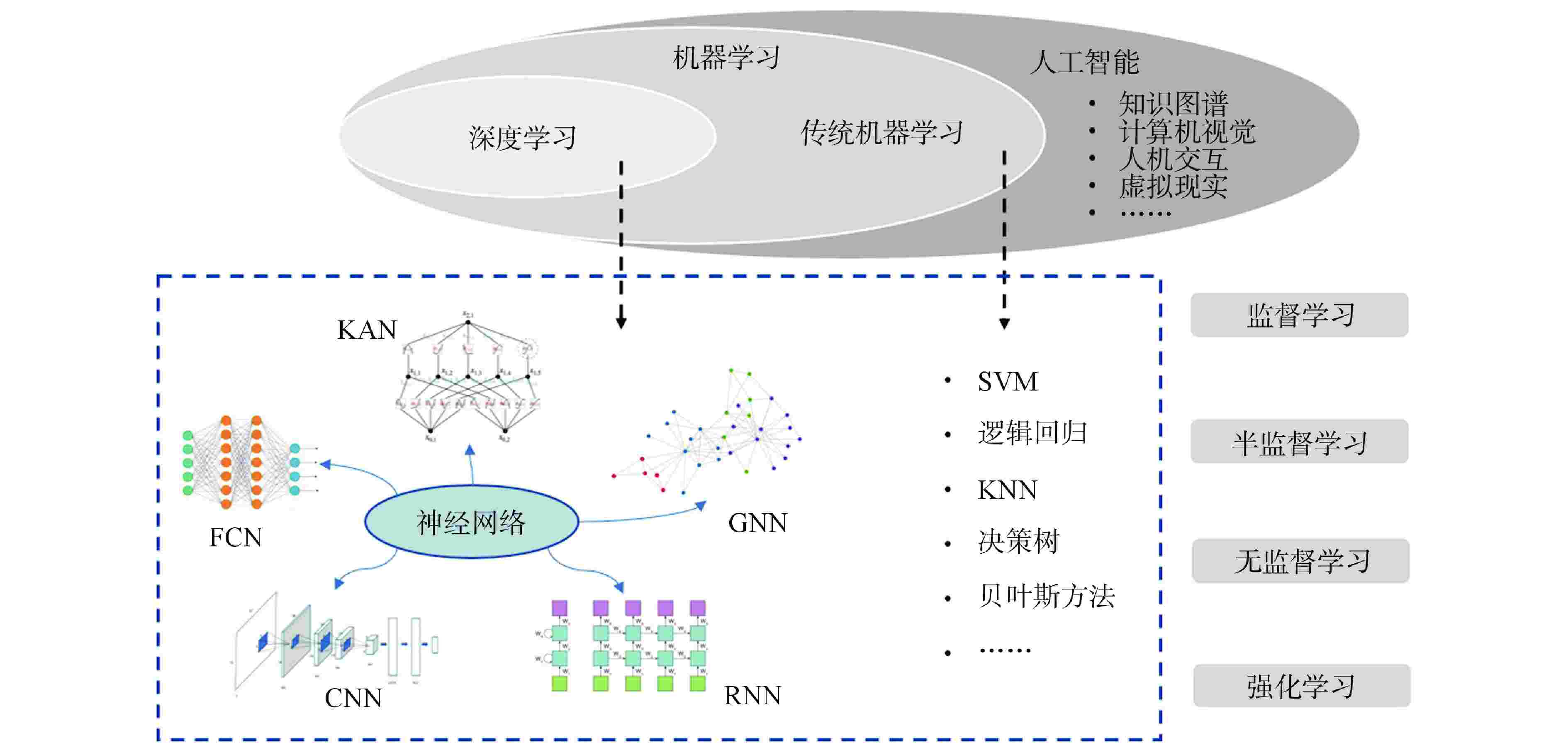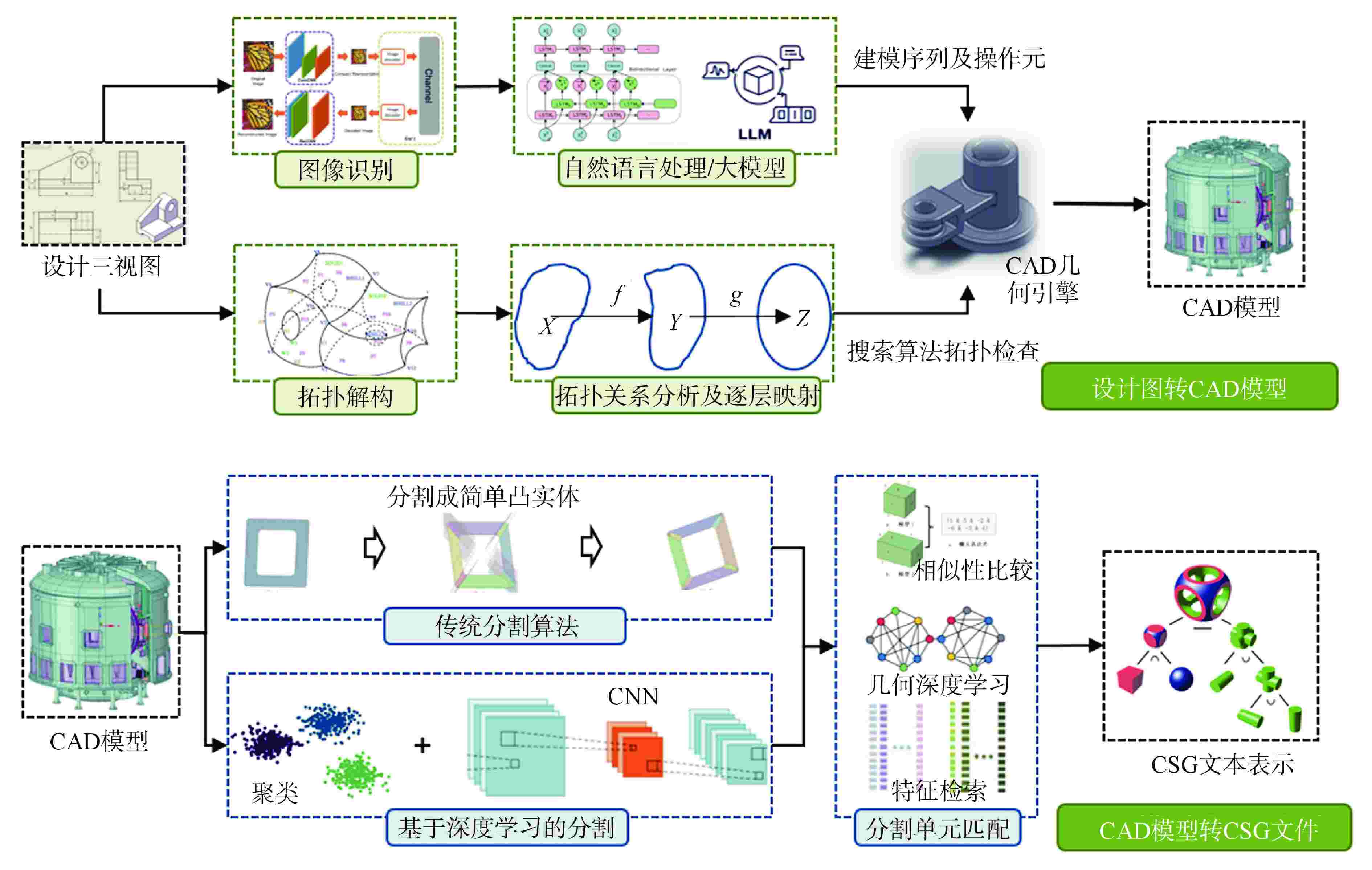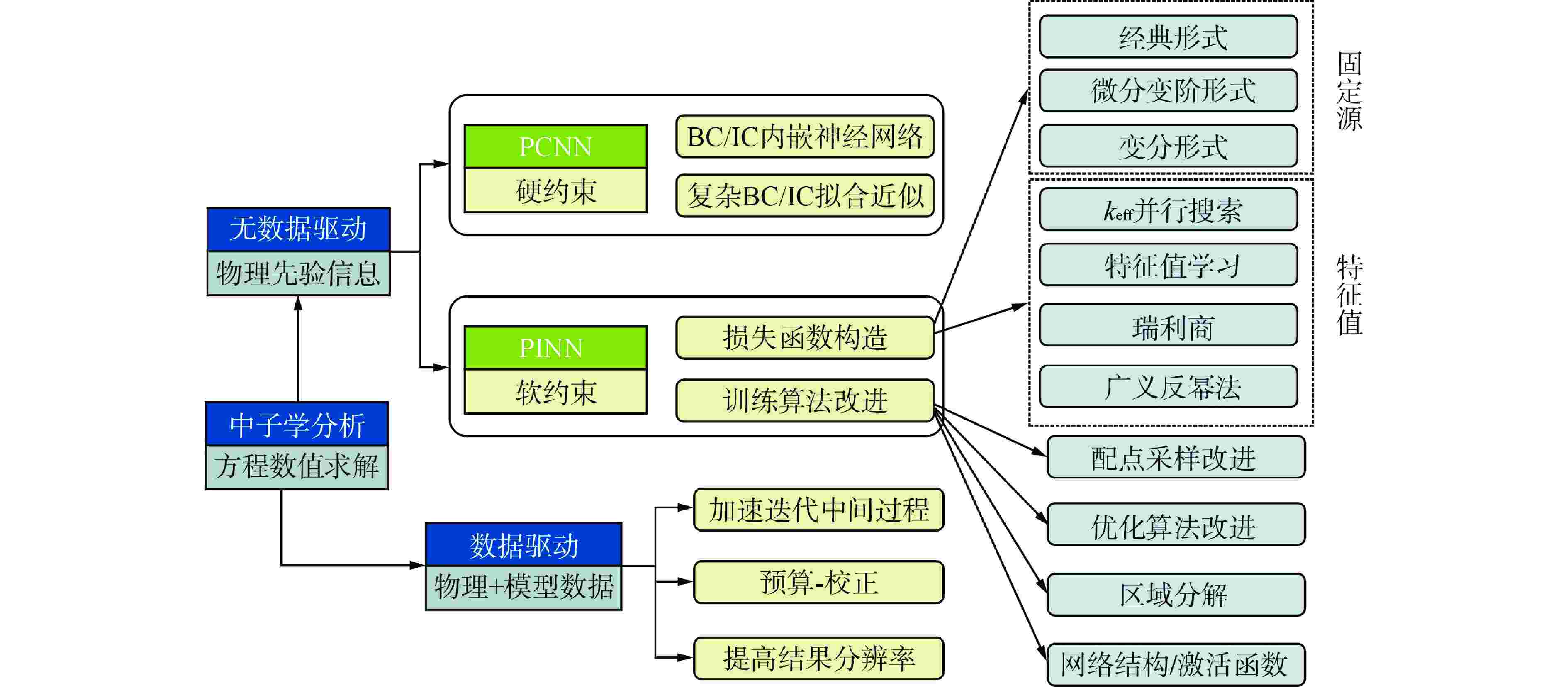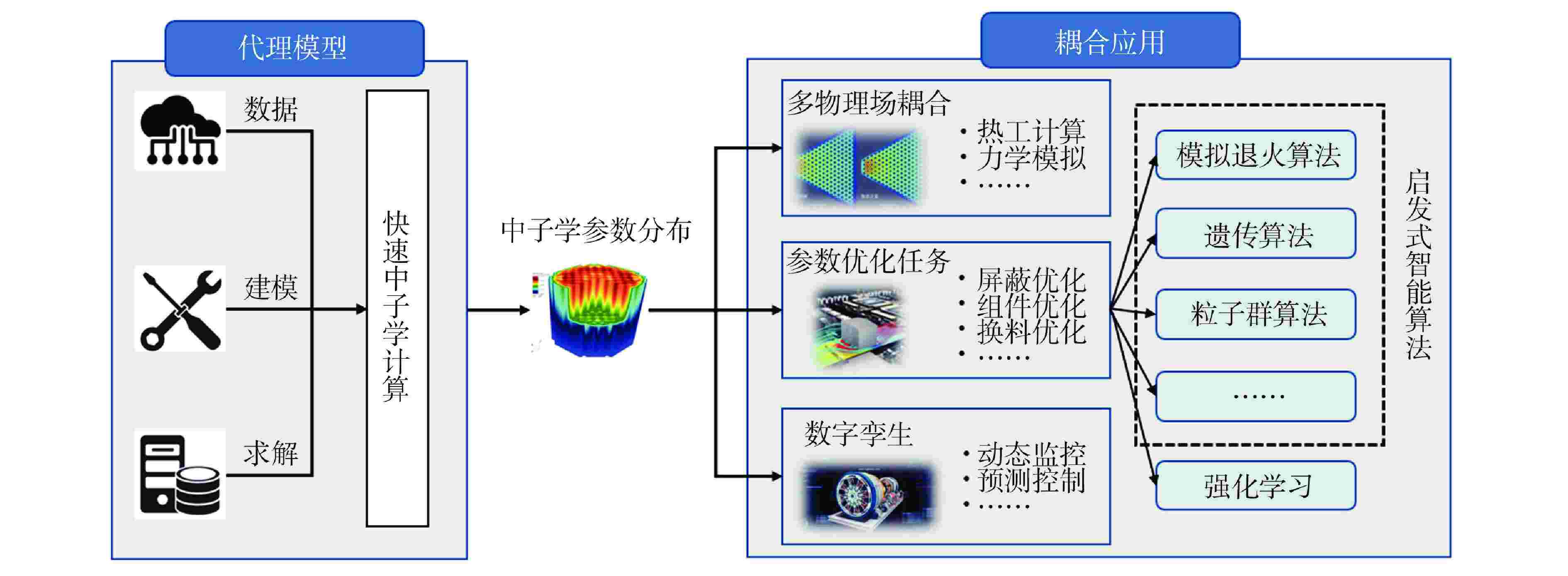| [1] |
吴宏春. 高等核反应堆物理[M]. 北京: 科学出版社,2023: 4-39.
|
| [2] |
邓力,李刚. 粒子输运问题的蒙特卡罗模拟方法与应用(上册)[M]. 北京: 科学出版社,2019: 42-86.
|
| [3] |
BI K F, XIE L X, ZHANG H H, et al. Accurate medium-range global weather forecasting with 3D neural networks[J]. Nature, 2023, 619(7970): 533-538. doi: 10.1038/s41586-023-06185-3
|
| [4] |
JUMPER J, EVANS R, PRITZEL A, et al. Highly accurate protein structure prediction with AlphaFold[J]. Nature, 2021, 596(7873): 583-589.
|
| [5] |
ZHANG L W, WANG Z Y, ZHANG Q X, et al. CLAY: a controllable large-scale generative model for creating high-quality 3D assets[J]. ACM Transactions on Graphics (TOG), 2024, 43(4): 120.
|
| [6] |
BROOKS T, PEEBLES B, HOLMES C, et al. Video generation models as world simulators[EB/OL].(2024-02-15)[2024-10-25]. https://openai.com/index/video-generation-models-as-world-simulators/.
|
| [7] |
YU J, LU L, MENG X H, et al. Gradient-enhanced physics-informed neural networks for forward and inverse PDE problems[J]. Computer Methods in Applied Mechanics and Engineering, 2022, 393: 114823. doi: 10.1016/j.cma.2022.114823
|
| [8] |
LI Z Y, KOVACHKI N B, AZIZZADENESHELI K, et al. Fourier neural operator for parametric partial differential equations[C]//9th International Conference on Learning Representations, ICLR 2021. Virtual Event, Austria, 2021.
|
| [9] |
PENG B, WEI Y, QIN Y, et al. Machine learning-enabled constrained multi-objective design of architected materials[J]. Nature Communications, 2023, 14(1): 6630. doi: 10.1038/s41467-023-42415-y
|
| [10] |
GEBAUER N W A, GASTEGGER M, HESSMANN S S P, et al. Inverse design of 3D molecular structures with conditional generative neural networks[J]. Nature Communications, 2022, 13(1): 973. doi: 10.1038/s41467-022-28526-y
|
| [11] |
中国电子技术标准化研究院. 人工智能标准化白皮书(2018版)20180117(3)[R]. 北京: 中国电子技术标准化研究院,2018.
|
| [12] |
SUTTON R S, BARTO A G. Reinforcement learning: an introduction[M]. 2nd ed. Cambridge: The MIT Press, 2018: 1-22.
|
| [13] |
李航. 机器学习方法[M]. 北京: 清华大学出版社,2022: 415-446.
|
| [14] |
SCARSELLI F, GORI M, TSOI A C, et al. The graph neural network model[J]. IEEE Transactions on Neural Networks, 2009, 20(1): 61-80. doi: 10.1109/TNN.2008.2005605
|
| [15] |
MICHELI A. Neural network for graphs: a contextual constructive approach[J]. IEEE Transactions on Neural Networks, 2009, 20(3): 498-511. doi: 10.1109/TNN.2008.2010350
|
| [16] |
BRONSTEIN M M, BRUNA J, LECUN Y, et al. Geometric deep learning: going beyond euclidean data[J]. IEEE Signal Processing Magazine, 2017, 34(4): 18-42.
|
| [17] |
WU Z X, WANG J K, DU H Y, et al. Chemistry-intuitive explanation of graph neural networks for molecular property prediction with substructure masking[J]. Nature Communications, 2023, 14(1): 2585.
|
| [18] |
ALET F, JEEWAJEE A K, VILLALONGA M B, et al. Graph element networks: adaptive, structured computation and memory[C]//Proceedings of the 36th International Conference on Machine Learning. Long Beach: PMLR, 2019: 212-222.
|
| [19] |
LIU Z M, WANG Y X, VAIDYA S, et al. KAN: kolmogorov-arnold networks[J]. arXiv: 2404.19756, 2024.
|
| [20] |
LIU Z M, MA P C, WANG Y X, et al. KAN 2.0: kolmogorov-arnold networks meet science[J]. arXiv: 2408.10205, 2024.
|
| [21] |
LOVELL A, MOHAN A, TALOU P, et al. Constraining fission yields using machine learning[C]//5th International Workshop on Nuclear Data Evaluation for Reactor Applications. Aix-en-Provence: EPJ, 2019: 04006.
|
| [22] |
AKKOYUN S. Estimation of fusion reaction cross-sections by artificial neural networks[J]. Nuclear Instruments and Methods in Physics Research Section B: Beam Interactions with Materials and Atoms, 2020, 462: 51-54.
|
| [23] |
RODRIGUEZ A, LAM S, HU M. Thermodynamic and transport properties of LiF and FLiBe molten salts with deep learning potentials[J]. ACS Applied Materials & Interfaces, 2021, 13(46): 55367-55379.
|
| [24] |
WANG H, ZHANG L F, HAN J Q, et al. DeePMD-kit: a deep learning package for many-body potential energy representation and molecular dynamics[J]. Computer Physics Communications, 2018, 228: 178-184.
|
| [25] |
THEODORIDIS S. Machine learning: a bayesian and optimization perspective[M]. 2nd ed. Amsterdam: Elsevier, 2020: 27-28.
|
| [26] |
WANG Z A, PEI J C, LIU Y, et al. Bayesian evaluation of incomplete fission yields[J]. Physical Review Letters, 2019, 123(12): 122501. doi: 10.1103/PhysRevLett.123.122501
|
| [27] |
BOEHNLEIN A, DIEFENTHALER M, SATO N, et al. Colloquium: machine learning in nuclear physics[J]. Reviews of Modern Physics, 2022, 94(3): 031003. doi: 10.1103/RevModPhys.94.031003
|
| [28] |
CATACORA-RIOS M, KING G B, LOVELL A E, et al. Exploring experimental conditions to reduce uncertainties in the optical potential[J]. Physical Review C, 2019, 100(6): 064615. doi: 10.1103/PhysRevC.100.064615
|
| [29] |
GOODFELLOW I, BENGIO Y, COURVILLE A. Deep learning[M]. Cambridge: The MIT Press, 2016: 157-161.
|
| [30] |
MITRA S, CHOI H, LIU S S, et al. Unmasking correlations in nuclear cross sections with graph neural networks[J]. arXiv: 2404.02332, 2024.
|
| [31] |
DORVILLE J J C. Advancing nuclear reactor simulations using ray tracing, machine learning and kinematic models of energy deposition[D]. Golden: Colorado School of Mines, 2023.
|
| [32] |
CHAN Y M, DUFEK J. A deep-learning representation of multi-group cross sections in lattice calculations[J]. Annals of Nuclear Energy, 2024, 195: 110123. doi: 10.1016/j.anucene.2023.110123
|
| [33] |
DZIANISAU S, SAEJU K, LEE H C, et al. Development of an artificial neural network model for generating macroscopic cross-sections for RAST-AI[J]. Annals of Nuclear Energy, 2023, 186: 109777.
|
| [34] |
WANG S C, CAO L Z, LI Y Z, et al. An energy-group structure optimization from seven to four for PWR-core pin-by-pin calculation[J]. Nuclear Engineering and Design, 2023, 402: 112115. doi: 10.1016/j.nucengdes.2022.112115
|
| [35] |
舒文玉. 多群屏蔽数据库制作方法研究及基于CENDL 3.2的自主化多群屏蔽库制作[D]. 西安: 西安交通大学,2022.
|
| [36] |
MASSONE M, GABRIELLI F, RINEISKI A. A genetic algorithm for multigroup energy structure search[J]. Annals of Nuclear Energy, 2017, 105: 369-387. doi: 10.1016/j.anucene.2017.03.022
|
| [37] |
WILSON P P H, TAUTGES T J, KRAFTCHECK J A, et al. Acceleration techniques for the direct use of CAD-based geometry in fusion neutronics analysis[J]. Fusion Engineering and Design, 2010, 85(10-12): 1759-1765. doi: 10.1016/j.fusengdes.2010.05.030
|
| [38] |
REGASSA HUNDE B, DEBEBE WOLDEYOHANNES A. Future prospects of computer-aided design (CAD) – a review from the perspective of artificial intelligence (AI), extended reality, and 3D printing[J]. Results in Engineering, 2022, 14: 100478.
|
| [39] |
CHEN T R, YU C N, HU Y Q, et al. Img2CAD: conditioned 3D CAD model generation from single image with structured visual geometry[J]. arXiv: 2410.03417, 2024.
|
| [40] |
YOU Y, UY M A, HAN J Q, et al. Img2CAD: reverse engineering 3D CAD models from images through VLM-assisted conditional factorization[J]. arXiv: 2408.01437, 2024.
|
| [41] |
HOANG L. 3D solid reconstruction from 2D orthographic views[M]//SOBOTA B, CVETKOVIĆ D. Mixed Reality and Three-Dimensional Computer Graphics. London: IntechOpen, 2020.
|
| [42] |
王国忠,程梦云,龙鹏程,等. 基于相似性评价的辐射输运计算建模方法研究[J]. 核科学与工程,2015, 35(3): 458-463. doi: 10.3969/j.issn.0258-0918.2015.03.010
|
| [43] |
罗月童. 模型变换技术及其在MCNP建模中的应用研究[D]. 合肥: 合肥工业大学,2005.
|
| [44] |
郝丽,莫蓉,魏斌斌,等. 基于图谱理论和聚类的三维CAD模型分割方法: 中国,109241628B[P]. 2018-09-08.
|
| [45] |
LAMBOURNE J G, WILLIS K D D, JAYARAMAN P K, et al. BRepNet: a topological message passing system for solid models[C]//Proceedings of the 2021 IEEE/CVF Conference on Computer Vision and Pattern Recognition (CVPR). Nashville: IEEE, 2021: 12768-12777.
|
| [46] |
LUO Y T, DU H, YAN Y M. MeshCNN-based BREP to CSG conversion algorithm for 3D CAD models and its application[J]. Nuclear Science and Techniques, 2022, 33(6): 74. doi: 10.1007/s41365-022-01063-5
|
| [47] |
HANOCKA R, HERTZ A, FISH N, et al. MeshCNN: a network with an edge[J]. ACM Transactions on Graphics, 2019, 38(4): 90.
|
| [48] |
詹高扬. 面向设计重用的三维CAD模型检索方法研究[D]. 杭州: 杭州电子科技大学,2023.
|
| [49] |
周波,郭正跃,韩承村,等. 基于图卷积网络的BREP→CSG转换方法及其应用研究[J]. 图学学报,2022, 43(1): 101-109.
|
| [50] |
DISSANAYAKE M W M G, PHAN-THIEN N. Neural-network-based approximations for solving partial differential equations[J]. Communications in Numerical Methods in Engineering, 1994, 10(3): 195-201.
|
| [51] |
RAISSI M, PERDIKARIS P, KARNIADAKIS G E. Physics-informed neural networks: a deep learning framework for solving forward and inverse problems involving nonlinear partial differential equations[J]. Journal of Computational Physics, 2019, 378: 686-707. doi: 10.1016/j.jcp.2018.10.045
|
| [52] |
CUOMO S, DI COLA V S, GIAMPAOLO F, et al. Scientific machine learning through physics–informed neural networks: where we are and what’s next[J]. Journal of Scientific Computing, 2022, 92(3): 88. doi: 10.1007/s10915-022-01939-z
|
| [53] |
XIE Y C, WANG Y H, MA Y. Boundary dependent physics-informed neural network for solving neutron transport equation[J]. Annals of Nuclear Energy, 2024, 195: 110181. doi: 10.1016/j.anucene.2023.110181
|
| [54] |
XIE Y C, CHI H H, WANG Y H, et al. Physics-specialized neural network with hard constraints for solving multi-material diffusion problems[J]. Computer Methods in Applied Mechanics and Engineering, 2024, 430: 117223.
|
| [55] |
XIE Y C, MA Y H, WANG Y. Automatic boundary fitting framework of boundary dependent physics-informed neural network solving partial differential equation with complex boundary conditions[J]. Computer Methods in Applied Mechanics and Engineering, 2023, 414: 116139. doi: 10.1016/j.cma.2023.116139
|
| [56] |
刘东,王雪强,张斌,等. 深度学习方法求解中子输运方程的微分变阶理论[J]. 原子能科学技术,2023, 57(5): 946-959. doi: 10.7538/yzk.2023.youxian.0002
|
| [57] |
KHARAZMI E, ZHANG Z Q, KARNIADAKIS G E M. hp-VPINNs: variational physics-informed neural networks with domain decomposition[J]. Computer Methods in Applied Mechanics and Engineering, 2021, 374: 113547. doi: 10.1016/j.cma.2020.113547
|
| [58] |
刘东,罗琦,唐雷,等. 基于PINN深度机器学习技术求解多维中子学扩散方程[J]. 核动力工程,2022, 43(2): 1-8.
|
| [59] |
YANG Y, GONG H L, ZHANG S Q, et al. A data-enabled physics-informed neural network with comprehensive numerical study on solving neutron diffusion eigenvalue problems[J]. Annals of Nuclear Energy, 2023, 183: 109656. doi: 10.1016/j.anucene.2022.109656
|
| [60] |
E W N, YU B. The deep ritz method: a deep learning-based numerical algorithm for solving variational problems[J]. Communications in Mathematics and Statistics, 2018, 6(1): 1-12.
|
| [61] |
YANG Q H, YANG Y, DENG Y T, et al. Physics-constrained neural network for solving discontinuous interface K-eigenvalue problem with application to reactor physics[J]. Nuclear Science and Techniques, 2023, 34(10): 161. doi: 10.1007/s41365-023-01313-0
|
| [62] |
LU L, MENG X H, MAO Z P, et al. DeepXDE: a deep learning library for solving differential equations[J]. SIAM Review, 2021, 63(1): 208-228. doi: 10.1137/19M1274067
|
| [63] |
WANG S F, TENG Y J, PERDIKARIS P. Understanding and mitigating gradient flow pathologies in physics-informed neural networks[J]. SIAM Journal on Scientific Computing, 2021, 43(5): A3055-A3081. doi: 10.1137/20M1318043
|
| [64] |
LIU L, ZENG T Y, ZHANG Z C. A deep neural network approach on solving the linear transport model under diffusive scaling[J]. arXiv: 2102.12408, 2021.
|
| [65] |
WANG J Y, PENG X J, CHEN Z, et al. Surrogate modeling for neutron diffusion problems based on conservative physics-informed neural networks with boundary conditions enforcement[J]. Annals of Nuclear Energy, 2022, 176: 109234. doi: 10.1016/j.anucene.2022.109234
|
| [66] |
JAGTAP A D, KHARAZMI E, KARNIADAKIS G E. Conservative physics-informed neural networks on discrete domains for conservation laws: applications to forward and inverse problems[J]. Computer Methods in Applied Mechanics and Engineering, 2020, 365: 113028.
|
| [67] |
JAGTAP A D, KAWAGUCHI K, EM KARNIADAKIS G. Locally adaptive activation functions with slope recovery for deep and physics-informed neural networks[J]. Proceedings of the Royal Society A: Mathematical, Physical and Engineering Sciences, 2020, 476(2239): 20200334. doi: 10.1098/rspa.2020.0334
|
| [68] |
WANG S F, YU X L, PERDIKARIS P. When and why PINNs fail to train: a neural tangent kernel perspective[J]. Journal of Computational Physics, 2022, 449: 110768. doi: 10.1016/j.jcp.2021.110768
|
| [69] |
XU Z Q J, ZHANG T Y, LUO T, et al. Frequency principle: Fourier analysis sheds light on deep neural networks[J]. Communications in Computational Physics, 2020, 28(5): 1746-1767. doi: 10.4208/cicp.OA-2020-0085
|
| [70] |
RAHAMAN N, BARATIN A, ARPIT D, et al. On the spectral bias of neural networks[C]//Proceedings of the 36th International Conference on Machine Learning. Long Beach: PMLR, 2019: 5301-5310.
|
| [71] |
LI X Q, ZHENG Y Q, DU X N, et al. A new surrogate method for the neutron kinetics calculation of nuclear reactor core transients[J]. Nuclear Engineering and Technology, 2024, 56(9): 3571-3584.
|
| [72] |
马锐垚,王鑫,李树,等. 基于神经网络的粒子输运问题高效计算方法[J]. 物理学报,2024, 73(7): 072802.
|
| [73] |
刘家旺,刘宙宇,曹良志,等. 基于深度学习的中子输运求解方法研究[C]//第二十届反应堆数值计算与粒子输运学术会议暨2024年反应堆物理会议. 哈尔滨,中国,2024.
|
| [74] |
LEI K H, WU H C, LIU Z Y, et al. SN-MscaleDNN: a coupling approach for rapid shielding-scheme evaluation of micro gas-cooled reactor in the large design-parameter space[J]. Annals of Nuclear Energy, 2024, 196: 110241. doi: 10.1016/j.anucene.2023.110241
|
| [75] |
BERRY J, ROMANO P, OSBORNE A. Upsampling monte carlo reactor simulation tallies in depleted sodium-cooled fast reactor assemblies using a convolutional neural network[J]. Energies, 2024, 17(9): 2177. doi: 10.3390/en17092177
|
| [76] |
OSBORNE A, DORVILLE J, ROMANO P. Upsampling Monte Carlo neutron transport simulation tallies using a convolutional neural network[J]. Energy and AI, 2023, 13: 100247. doi: 10.1016/j.egyai.2023.100247
|
| [77] |
张俊达,刘晓晶,熊进标,等. 基于神经网络的热管反应堆多物理场耦合快速预测[J]. 原子能科学技术,2024, 58(6): 1218-1225.
|
| [78] |
WAN C H, LEI K H, LI Y S. Optimization method of fuel-reloading pattern for PWR based on the improved convolutional neural network and genetic algorithm[J]. Annals of Nuclear Energy, 2022, 171: 109028.
|
| [79] |
雷铠灰,曹良志,万承辉,等. 基于深度卷积神经网络的堆芯换料方案性能评价研究[J]. 原子能科学技术,2021, 55(2): 279-285. doi: 10.7538/yzk.2020.youxian.0111
|
| [80] |
SONG Y M, MAO J, ZHANG Z H, et al. A novel multi-objective shielding optimization method: DNN-PCA-NSGA-II[J]. Annals of Nuclear Energy, 2021, 161: 108461. doi: 10.1016/j.anucene.2021.108461
|
| [81] |
于志翔,邹树梁,徐守龙,等. 基于BP神经网络的船用反应堆屏蔽设计快速计算功能研究[J]. 核电子学与探测技术,2016, 36(2): 209-213. doi: 10.3969/j.issn.0258-0934.2016.02.022
|
| [82] |
GONG H L, CHENG S B, CHEN Z, et al. Data-enabled physics-informed machine learning for reduced-order modeling digital twin: application to nuclear reactor physics[J]. Nuclear Science and Engineering, 2022, 196(6): 668-693.
|
| [83] |
康崇禄. 蒙特卡罗方法理论和应用[M]. 北京: 科学出版社,2015: 142-143.
|
| [84] |
BUTT M K, CAO L Z, WAN C H, et al. Integrating the deep learning and multi-objective genetic algorithm to the reloading pattern optimization of HPR1000 reactor core[J]. Nuclear Engineering and Design, 2024, 428: 113531. doi: 10.1016/j.nucengdes.2024.113531
|
| [85] |
CHEN Z P, ZHANG Z Y, XIE J S, et al. Multi-objective optimization strategies for radiation shielding design with genetic algorithm[J]. Computer Physics Communications, 2021, 260: 107267. doi: 10.1016/j.cpc.2020.107267
|
| [86] |
WU X, YANG Y W, HAN S, et al. Multi-objective optimization method for nuclear reactor radiation shielding design based on PSO algorithm[J]. Annals of Nuclear Energy, 2021, 160: 108404. doi: 10.1016/j.anucene.2021.108404
|
| [87] |
RADAIDEH M I, WOLVERTON I, JOSEPH J, et al. Physics-informed reinforcement learning optimization of nuclear assembly design[J]. Nuclear Engineering and Design, 2021, 372: 110966. doi: 10.1016/j.nucengdes.2020.110966
|
| [88] |
RADAIDEH M I, SHIRVAN K. Rule-based reinforcement learning methodology to inform evolutionary algorithms for constrained optimization of engineering applications[J]. Knowledge-Based Systems, 2021, 217: 106836. doi: 10.1016/j.knosys.2021.106836
|
| [89] |
雷铠灰,吴宏春,贺清明,等. 基于多频率尺度神经网络和改进型NSGA-II算法的气冷微堆屏蔽多目标优化方法研究[C]//第二十届反应堆数值计算与粒子输运学术会议暨2024年反应堆物理会议. 哈尔滨,黑龙江,2024.
|
| [90] |
REN K, ZHENG T H, QIN Z, et al. Adversarial attacks and defenses in deep learning[J]. Engineering, 2020, 6(3): 346-360. doi: 10.1016/j.eng.2019.12.012
|
| [91] |
GOODFELLOW I, SHLENS J, SZEGEDY C. Explaining and harnessing adversarial examples[C]//3rd International Conference on Learning Representations. San Diego: ICLR, 2015.
|
| [92] |
张恒,吕雪,刘东,等. 核电人工智能应用: 现状、挑战和机遇[J]. 核动力工程,2023, 44(1): 1-8.
|
| [93] |
JACOT A, GABRIEL F, HONGLER C. Neural tangent kernel: convergence and generalization in neural networks[C]//Proceedings of the 32nd International Conference on Neural Information Processing Systems. Montréal: Curran Associates Inc. , 2018: 8580-8589.
|
| [94] |
YANG Q, LIU Y, CHEN T J, et al. Federated machine learning: concept and applications[J]. ACM Transactions on Intelligent Systems and Technology (TIST), 2019, 10(2): 12.
|






 下载:
下载:






